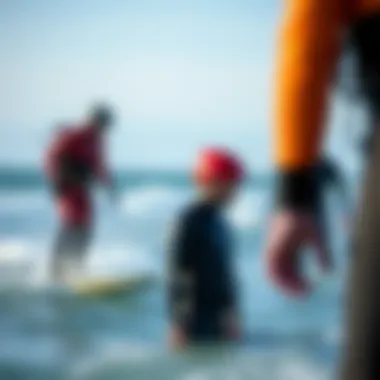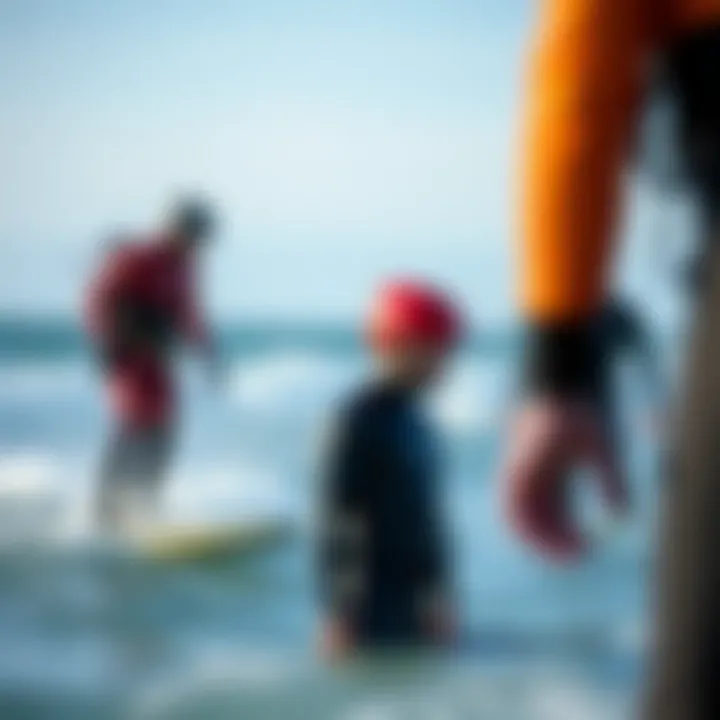Understanding Cold Water Wetsuit Thickness for Kiteboarding


Intro
Cold water kiteboarding is not for the faint of heart. Chilly winds and frigid waves demand preparation and proper gear to ensure safety and comfort. At the heart of this gear is the wetsuit, whose thickness plays a pivotal role in maintaining body temperature while riding the waves. With a little know-how, you can make an informed choice about the right wetsuit thickness for your cold water kiteboarding adventures.
As temperatures dip, the importance of understanding wetsuit insulation and material becomes critical. When you’re out there battling waves, feeling confident and comfortable should be your top priority. Throughout this guide, we’ll cover essential aspects, like how thermoregulation—and the activity’s intensity impacts your comfort level. As we dive deeper, we'll explore the unique needs of kiteboarders, industry standards, and even ways to compare products.
Let's embark on this journey together and gear up for an exhilarating kiteboarding experience, even when the water looks icy.
Gear Selection
When venturing into the world of cold water kiteboarding, it's vital to have the right gear. This isn’t merely about the wetsuit; it also includes the kites and boards you choose. Ultimately, your performance and enjoyment hinge on how well you select these essential pieces.
Types of Kites
Selecting the right kite can vastly affect your performance in cold water conditions. Here are a few types to consider:
- Foil Kites: These are great for light wind conditions, providing excellent lift and stability on the water. They perform well in colder conditions, allowing you to stay up and ride even when the breeze is thin.
- Leisure Kites: Designed for casual riders, these are more forgiving and easier to control, which may help beginners focus on their technique without the pressure of quickly acclimating to cold water.
- SLE (Soft Leading Edge) Kites: With their unique shapes and designs, SLE kites excel in gusty winds. If you expect variable conditions, these can be a solid choice for both performance and enjoyment.
Choosing the right kite is akin to pairing a fine wine with your meal—match the kite's capabilities with the environment, and enjoyment follows naturally.
Choosing the Right Board
A kiteboard is something that can make or break your kiteboarding experience, especially in cold water.
- Directional Boards: These are great for surfing the waves. With their narrower shape, they slice through water efficiently, which is a significant advantage in chilly conditions.
- Twin-Tip Boards: These are more versatile for freestyle tricks and have a balanced design, allowing you to tackle various conditions. Plus, they can handle the unpredictable nature of cold water more effectively.
When searching for your perfect match, assess factors like your skill level, the conditions, and your personal riding style. Remember, a good fit can mean the difference between a joyride and a battle against the elements.
The End
Choosing the right wetsuit, kite, and board lays the foundation for a successful cold water kiteboarding adventure. Mind how you match your gear to the conditions and your preferences. With the insights shared in this article, you’ll be well-equipped to make informed choices, ensuring that your cold water sessions are enjoyable and safe.
"Cold water doesn’t mean you should stay onshore. With the right wetsuit and gear, you can enjoy the thrill that awaits."
For those keen on diving deeper into this captivating sport, visit reliable sources such as Wikipedia, Britannica, or community discussions on Reddit.
Stay tuned for more on techniques and progression tips tailored to elevate your kiteboarding game!
Prelude to Cold Water Wetsuits
Cold water wetsuits serve a crucial role in the pursuit of kiteboarding, especially in regions where the air is crisp and the waters are even chillier. The choice of wetsuit thickness is not just about comfort; it can significantly influence a rider’s performance, safety, and enjoyment on the waves. Underestimating the importance of a proper wetsuit can lead to uncomfortable sessions, or worse, hypothermia. By understanding the various elements of cold water wetsuits, kiteboarders can make informed decisions that enhance their experience.
Definition and Purpose
A cold water wetsuit is designed to insulate the body against the cold temperatures of water, typically under 60°F (15°C). These wetsuits are crafted using neoprene, a type of synthetic rubber that traps a thin layer of water between the suit and the skin. As a kiteboarder moves, body heat warms this trapped water, providing thermal insulation while allowing for greater flexibility than drysuits.
The primary purpose of these wetsuits is twofold:
- Thermal Protection: They prevent rapid heat loss in cold water, allowing kiteboarders to stay in the water longer without succumbing to the cold.
- Injury Prevention: They can also provide a layer of protection against scrapes, stings, and impacts that a rider may encounter while navigating through rough waters.
When kiteboarding in chilly conditions, choosing the right thickness of wetsuit can mean the difference between a delightful day out and a frozen regret.
Importance in Kiteboarding
In kiteboarding, ensuring that you have the right wetsuit is paramount for a few reasons:
- Performance: The freedom of movement offered by wisely chosen wetsuit thickness allows riders to maneuver effectively, whether executing jumps or making quick turns.
- Safety: Staying warm translates to improved focus and decision-making on the water. When the body is under stress from cold temperatures, cognitive functions can diminish, leading to slower reaction times.
- Stamina: With the right wetsuit, practitioners can enjoy longer sessions. No one wants to call it quits because of the chills setting in, right?
Ultimately, cold water wetsuits not only protect against hypothermia but also ensure the kiteboarding experience is as enjoyable and dynamic as the waves themselves. Understanding the nature of these wetsuits is a step towards mastering the art of kiteboarding in all conditions, regardless of how icy the water may be.
Thermal Dynamics in Wetsuit Design
The way a wetsuit traps heat is an essential factor in ensuring comfort and safety for kiteboarders who take to the water in chilly conditions. Understanding the thermal dynamics in wetsuit design provides insight into how these garments function and why their construction is pivotal for maintaining body temperature in cold water.
When you’re surfing the waves in below-average temperatures, the last thing you want is to feel like you’re in an ice box. A well-designed wetsuit will effectively manage heat retention, allowing you to focus on riding rather than shivering.
Mechanisms of Heat Retention
Wetsuits operate on a simple yet effective principle of insulation. The primary way they retain heat is through a layer of water that enters the suit when you first put it on. This layer warms up quickly due to the body heat generated from your movements.


The thickness of neoprene—the material most commonly used in wetsuits—plays a key role here. Thicker neoprene provides greater insulation, which can help keep you warm even when the water temperature dips. Typically, wetsuits range from 2mm to 6mm in thickness, with most cold water suits being in the range of 4mm to 5mm.
While thickness is important, the suit's design also matters. Features like:
- Taped Seams: These prevent water from entering through the stitches, helping keep that warm layer of water intact.
- Fluid Seals: Applied at the cuffs and neck to minimize water entry, it also ensures a snug fit, which translates to better heat retention.
- Hooded Variants: Some suits come with hoods to keep your head warm, which is crucial since a significant amount of body heat is lost through the head.
These elements combine to create a barrier against the chill, allowing kiteboarders to stay out and enjoy the ride longer.
Impact of Water Temperature
Water temperature is not just a number; it’s the key element that influences the type of wetsuit you might choose. Cold water, characterized as temperatures below 15 degrees Celsius (59 degrees Fahrenheit), necessitates a thicker suit. At these lower temperatures, losing body heat becomes a real concern.
In these situations, being bundled up in a thicker suit could mean the difference between enjoying a full day of kiteboarding or heading back to shore feeling like a popsicle. Each degree drop can increase the risk of hypothermia, hence why knowing the conditions is crucial.
Here are some pointers on how temperature affects wetsuit selection:
- Above 15°C (59°F): A 3mm suit may suffice for short sessions, but if you're prone to cold or planning to stay out a while, consider a thicker option.
- 10°C to 15°C (50°F to 59°F): A 4mm suit is typically a safe bet, as it balances warmth and flexibility.
- Below 10°C (50°F): You’ll want to opt for a 5mm or thicker suit. In addition, accessories like gloves, booties, and hoods become increasingly important for maintaining warmth in these frigid waters.
By taking an accurate measure of water temperature and anticipating how long you plan to ride, you can choose a wetsuit that keeps you warm enough to enjoy the sport without worrying about the cold.
"Selecting the right wetsuit is as much about understanding your needs as it is about the environment you'll be riding in."
Considering both the mechanisms of heat retention and the impact of water temperature is essential for kiteboarders looking to enhance their performance while staying comfortable. Matching suit thickness with environmental conditions is not just smart; it's fundamental for prolonging your time on the water.
Understanding Wetsuit Thickness Standards
When it comes to kiteboarding in cold water, the choice of wetsuit thickness has a significant impact on performance and comfort. Selecting the right thickness can be the difference between a frigid ride and a warm session, enabling kiteboarders to stay in the water longer, maximizing enjoyment without compromising safety. It’s crucial to understand the various thickness standards that exist within the industry and how they relate to the environmental conditions and personal preferences of each kiteboarder. By grasping these standards, riders can make informed choices that cater to their unique needs.
Thickness Ratings Explained
Wetsuits are typically rated by their thickness in millimeters, which describes the neoprene thickness across different parts of the suit. This measurement is usually given in two figures, such as 4/3mm or 5/4mm. The first number indicates the thickness of the torso, while the second refers to the thickness of the arms and legs. Cumulatively, these ratings provide insight into the wetsuit's thermal insulation capabilities.
- So why does thickness matter? A thicker wetsuit generally offers better insulation against cold water, crucial for long rides in chilly conditions. However, it can also limit mobility, which is a vital aspect of kiteboarding. Finding that sweet spot between warmth and flexibility is essential.
Moreover, the thickness rating doesn’t just determine warmth; it also plays a role in how buoyant and streamlined the wetsuit is during action. Thicker suits can increase buoyancy, which some riders might find cumbersome, particularly in high-wind conditions.
Common Thickness Options
Most wetsuits come in a range of thicknesses that cater to various water temperatures and personal preferences. Here’s a breakdown of common thickness options:
- 2mm: Ideal for warm to temperate waters, around 60-70°F (15-21°C). This thickness is designed for those who want to maintain flexibility and mobility without feeling weighed down.
- 3/2mm: A popular choice for spring and fall seasons with water temps ranging from 55-65°F (13-18°C). It offers a balance between heat retention and movement.
- 4/3mm: Suited for chilly waters, approximately 50-60°F (10-15°C). This thickness provides better insulation but may restrict movement slightly, especially in the arms.
- 5/4mm: Recommended for waters below 50°F (10°C). Designed for extreme cold, these suits can sometimes feel bulky but are necessary for safety and warmth in harsh conditions.
Tip: Always keep in mind that personal comfort plays a vital role. It’s important to select a suit that feels right for your body and your kiteboarding style, even if that means choosing a thickness contrary to recommendations for the prevailing temperature.
Key Takeaways
Understanding wetsuit thickness standards is essential for kiteboarders, especially those venturing into cold water. It not only affects thermal protection but also impacts flexibility and buoyancy. By familiarizing themselves with the thickness ratings and options available, riders can ensure they have a wetsuit that meets their specific requirements, transforming their cold water experiences from a shivery ordeal to an enjoyable adventure.
Selecting the Right Wetsuit for Cold Water Kiteboarding
Picking the right wetsuit for cold water kiteboarding is fundamental to both enjoyment and safety in this thrilling water sport. Kiteboarding in chilly temperatures can be an invigorating experience, but without proper insulation, it can swiftly become unbearable. The wetsuit you choose acts as a barrier against the elements, helping you maintain warmth while allowing freedom of movement. A well-fitting wetsuit not only enhances comfort but also aids in performance, ensuring that every ride is as smooth as a fresh breeze.
Assessing Water Conditions
Understanding the specific water conditions where you'll be kiteboarding is vital. Factors such as temperature, wind speed, and current strength can greatly affect your choice of wetsuit.
- Temperature: Cold water temperatures generally require thicker wetsuits, usually ranging from 4mm to 6mm. Each region has its average water temperature during different seasons. For instance, a chilly morning session in the Atlantic might call for a robust wetsuit compared to a casual ride in balmy waters of the Pacific.
- Wind Speed and Conditions: Higher winds can lead to increased chill factors, making you feel colder than the actual water temperature. On blustery days, opting for a thicker suit or one with added thermal lining can help mitigate the effects of wind chill.
- Current and Waves: Strong currents require you to exert more energy while kiteboarding, leading to faster body heat loss. A wetsuit that fits snugly aids in keeping warmth close to the body, while also providing some buoyancy in challenging conditions.
In assessing these conditions, don’t just rely on a quick glance at the weather apps. Getting to know local kiteboarding spots, chatting with experienced riders, and even keeping personal records of water temperatures can significantly inform your wetsuit choice.
Evaluating Your Personal Needs
Moving beyond environmental factors, individual preferences and physiological traits play a significant role in selecting the right wetsuit.
- Body Type and Fit: Wetsuits are designed to fit snugly, so finding one that accommodates your shape is essential. Your body size and shape dictate how much insulation is required. Taller or heavier riders may need thicker suits or size adjustments to ensure effective warmth retention. Here’s a helpful tip: you want it to feel like a second skin, not a skin-tight band.
- Activity Level: Are you a dynamic rider pulling tricks or a casual kiteboarder enjoying the scenery? High-energy activities generate body heat but can also lead to overheating if the wetsuit is too thick. Knowing your intended activity level helps you pick a wetsuit that strikes the balance between warmth and comfort.
- Personal Sensitivity: Some individuals are naturally more sensitive to cold than others. If you tend to get chilled quickly, erring on the side of a thicker wetsuit might be the way to go. Remember, every additional millimeter counts when it comes to insulation.
"The right wetsuit doesn’t just keep you warm; it enhances your entire kiteboarding experience, allowing you to ride longer and harder without the chill disrupting your flow."
When selecting a wetsuit, combining insights from water conditions with a clear understanding of your personal preferences and needs creates a more enjoyable riding experience. Picking correctly arms you with the confidence to face cold waters head-on, embarking on memorable kiteboarding sessions that will stay with you long after you’ve hung up your kite.
For additional resources regarding wetsuit designs, temperatures, and rider testimonials, check out these links: Kiteboarding.com and Kite Forum for community insights.


Wetsuit Materials and Their Properties
The selection of wetsuit materials forms the backbone of performance and comfort when kiteboarding in cold water. As water plays it's part in chilling the body, the right wetsuit material can act as your personal armor against the elements. In this section, we'll dive into the different types of materials used in wetsuit construction, particularly focusing on neoprene and its variants, as well as the influence of material quality on warmth, flexibility, and durability.
Neoprene Variants
Neoprene serves as the cornerstone in the realm of wetsuit production. Generally, it comes in different variants, each tailored for specific conditions and user preferences:
- Standard Neoprene: This is the most basic form, providing decent insulation at an affordable price. However, it does not hold up well in varying temperatures and might feel bulky.
- Closed Cell Neoprene: This variant is designed with tiny bubbles that trap air, thus increasing thermal insulation. It’s well-suited for cold water, as it minimizes heat loss effectively.
- Open Cell Neoprene: Unlike its closed counterpart, this type is more flexible and provides superior comfort but lacks the same level of thermal retention. It works best in warmer conditions where mobility is prioritized over insulation.
- Chloroprene Rubber: Often marketed as eco-friendly, it's another alternative that offers a similar level of warmth while being more sustainable. It tends to be more expensive but is favored by environment-conscious riders.
Furthermore, advances in technology have led to alternatives like Yamamoto neoprene, made from limestone instead of petroleum, enhancing thermal efficiency while being lighter and more flexible.
Influence of Material Quality
The quality of the material used in wetsuits can't be overstated. Just because a wetsuit looks good, doesn't mean it performs well. Here are several aspects to consider about the influence of quality on your wetsuit experience:
- Thermal Insulation: Higher quality materials will provide better thermal insulation. Lower-end materials might split or lose their effectiveness after a few sessions, allowing cold water to seep in
- Flexibility: A well-constructed wetsuit allows for enhanced movement. Quality materials will stretch and recover without degrading, enabling you to maneuver with ease while kiteboarding. Think of it like wearing a second skin, except it actually should feel comfortable and not restrictive.
- Durability: The lifespan of your wetsuit is heavily dictated by the materials used. Durable suits can withstand rough handling, usage in saltwater, and are less prone to rips, tears, and UV deterioration from sun exposure.
- Water Resistance: Premium materials usually have better resistance to water absorption. This is important since a wetsuit that absorbs water significantly loses its insulation properties, leaving you feeling colder during your ride.
In summary, investing time and resources into understanding wetsuit materials will pay off in spades for kiteboarders. Whether you prioritize mobility, warmth, or sustainability, delving deeper into the specifics of materials can elevate your kiteboarding experience, even in the coldest waters. For more information on waterproof materials and performance gear, you can visit Wikipedia on Wetsuits or Britannica on Thermal Wear for further insights.
"The right material can mean the difference between a rugged session against the chill and an uncomfortably frigid experience."
Each kiteboarder has unique needs, and understanding the full spectrum of material properties can help in making an informed decision when selecting the perfect cold-water wetsuit.
Evaluating Fit and Comfort
Choosing the right wetsuit is more than just picking a fancy color or brand. It’s about how that suit hugs your body and impacts your performance on the water. In kiteboarding, where you can spend hours battling the waves in chilly conditions, a well-fitting wetsuit is essential for ensuring both comfort and safety. The fit can elevate your experience by helping you concentrate on the thrill of kiteboarding instead of adjusting your gear every few minutes.
Common Fit Issues
When selecting a wetsuit, many kiteboarders face some challenges with fit. Below are some common issues:
- Too Tight: A wetsuit that feels tighter than a vice can restrict your movement. If you're struggling to pull on the suit or bending feels like you're trying to fold a steel beam, it’s likely too tight.
- Too Loose: On the flip side, a suit that’s too baggy creates problems as well. Gaps can allow water to flow in and out, which means the suit won't keep you warm as it should. Cold water sloshing around inside can chill you faster than a freezing gust off the ocean.
- Inappropriate Length: Length matters, as a suit that is too short may ride up and leave parts of your body exposed to the cold. Conversely, if it’s too long, you may trip over the cuffs or find it hampers your agility on the board.
Identifying these fit issues early can save you time, money, and discomfort in the long run.
Finding Your Ideal Size
Finding your ideal wetsuit size can sometimes feel like searching for a needle in a haystack, but it doesn’t have to be like that. Here are some tips to help you zero in on the perfect size:
- Consult Sizing Guides: Most brands provide a sizing chart based on height, weight, and sometimes even your chest and waist measurements. Don’t skip this step, as it often makes the difference between comfort and suffering.
- Try Before You Buy: If possible, try the wetsuit on before purchasing. This gives you immediate insight into how it fits your body. A store with a fitting area is ideal for seeing how it feels when you move and stretch.
- Check Return Policies: Many online retailers offer satisfaction guarantees, enabling you to order multiple sizes and return the ones that don’t fit right. This option can be incredibly useful, especially because wetsuits can fit everyone differently due to various body shapes.
- Consider Your Layers: If you plan to wear base layers or thermal tops under your wetsuit for added warmth, account for that in your size selection. You don’t want to compromise fit by adding bulk.
Ultimately, a well-fitted wetsuit serves to enhance your experience while kiteboarding. Proper fit allows for better mobility, efficiency in movement, and greater thermal protection, ultimately maximizing your time on the water.
"A wetsuit that fits well is like a second skin; it should serve you and your performance, not hinder it."
For more details on sizing and specific recommendations, check resources from the Wetsuit Warehouse, where you can also find answers to your wetsuit fit questions.
Comparative Analysis of Wetsuit Brands
When it comes to kiteboarding in cold water, selecting the right wetsuit is a pivotal decision. Not all wetsuits are created equal, and the brands behind these suits often dictate quality, performance, and safety. A thorough comparative analysis of wetsuit brands helps kiteboarders make informed choices, ensuring they find the perfect match for their unique conditions and personal preferences.
Several significant elements come into play when considering different brands of cold water wetsuits. The materials used, the technology behind the construction, and the overall design impact both warmth and flexibility. Certain brands excel in innovating neoprene variants that not only enhance thermal insulation but also offer extended durability.
Additionally, brand reputation plays a role in a buyer's confidence. Established brands are often backed by years of research and development, assuring customers of their reliability. While newcomers may bring fresh ideas, experience still holds a lot of weight in an environment where safety and performance are paramount. In this context, it’s essential to consider how various brands address specific user needs, hydration points, and user feedback.
Leading Brands in Cold Water Wetsuits
A few leading brands stand out in the market of cold water wetsuits, noted for their commitment to quality and innovation:
- Xcel: Known for its high-performance wetsuits that balance warmth with flexibility, Xcel designs are often favored by professional kiteboarders.
- O'Neill: A pioneer in neoprene technology, O'Neill wetsuits are reliable and known for excellent craftsmanship, appealing to recreational and competitive kiteboarders alike.
- Rip Curl: This brand leverages extensive research to create wetsuits that cater to extreme conditions, allowing users to push their limits.
- Patagonia: With a focus on sustainability, Patagonia offers wetsuits that are not only functional but also environmentally friendly, resonating with eco-conscious riders.
When shopping for a wetsuit, it’s wise to consider brands that align with your values, whether those are performance-oriented, environmentally conscious, or price-driven.
Performance Reviews
Performance reviews play a vital role in the decision-making process regarding wetsuit selection, as they provide insight into the real-life experience of users. Here’s what to keep in mind when assessing reviews:
- Warmth Retention: Most reviews focus on how well the wetsuit maintains body temperature in cold water. Look for comments about user experiences during lengthy sessions in frigid conditions.
- Mobility and Flexibility: Performance can be hindered if a wetsuit is too bulky or restraining. Reviews should offer perspective on how easy it is to move in the suit, especially for activities like jumping and maneuvering on the board.
- Durability: Reviewers often comment on wear and tear over time, reflecting how a wetsuit holds up against rigorous use and environmental factors.
- Fit and Comfort: User feedback often highlights the importance of fit, detailing whether a suit runs true to size and its overall comfort during extended periods of wear.


"Choosing the right wetsuit can mean the difference between an exhilarating experience and a frigid ordeal. Always look for reviews that highlight key performance aspects suited for cold water conditions."
In summary, a comparative analysis of wetsuit brands reveals both the advantages and shortcomings of each option, ultimately leading to better purchasing decisions. It encourages kiteboarders to choose wisely and adapt their gear to the ever-changing conditions they face while riding.
Environmental Considerations in Wetsuit Production
Kiteboarding enthusiasts primarily think about performance and comfort when selecting a wetsuit. However, environmental considerations are just as important in today’s increasingly eco-conscious world. The surf and kiteboarding community relies heavily on the ocean and its ecosystems. Thus, analyzing the sustainable practices in wetsuit production can reveal the commitment of brands to not only the sport but also the environment.
Sustainable Material Choices
Wetsuits have long been made from traditional neoprene derived from petroleum. Unfortunately, this material has a significant ecological footprint. Many companies are now shifting to alternative materials, which present a lesser impact on the environment. Here are a couple of noteworthy options:
- Yulex: This natural rubber is made from sustainably harvested sources. It's biodegradable and has lower carbon emissions during production, offering a more eco-friendly alternative to traditional neoprene.
- Recycled Neoprene: Some brands are recycling old wetsuit materials, drastically cutting down on waste and the need for new raw materials. By employing innovative techniques, manufacturers can keep quality high while reducing their ecological footprint.
Transitioning to these materials answers the demand for sustainable goods among consumers. They want to engage in their favorite sport without contributing to environmental degradation.
Impact on Marine Ecosystems
Producing wetsuits does not just affect the air we breathe; it also impacts our oceans directly. Conventional production processes often lead to chemical runoff, which can be toxic to marine life. These chemicals can end up in the waters where kiteboarders enjoy their time, leading to detrimental effects on fish and other sea creatures. A few key impacts include:
- Pollution from Manufacturing: Chemicals used in traditional neoprene production can leach into oceans and rivers, affecting the quality of water and harming aquatic organisms.
- End-of-Life Disposal Issues: Wetsuits can contribute significantly to landfill waste. Traditional neoprene takes years to degrade, creating long-lasting pollution.
To combat these issues, brands focusing on sustainability often participate in cleanup initiatives, working to keep beaches and waters clean. They might also support research that advocates for the preservation of marine ecosystems, aligning their business goals with ecological health.
"There’s no harmony on Earth without a shared respect for its bounties. With the kiteboarding spirit, it’s about riding the waves and protecting what gives us joy."
Addressing the environmental impact in wetsuit production not only appeals to eco-conscious kiteboarders but also fosters a generation that values sustainable practices. By choosing wetsuits made from sustainable materials, kiteboarders can enjoy their sport responsibly, knowing they are actively participating in safeguarding the environment.
Care and Maintenance of Cold Water Wetsuits
Taking care of a cold water wetsuit is as essential as selecting the right thickness for those chilly kiteboarding adventures. Proper maintenance prolongs the life of your equipment, ensuring that it continues to perform at its best while also keeping you warm and mobile on the water. Understanding how to clean and store your wetsuit effectively can make all the difference—not just in comfort but in safety on the waves.
Cleaning Procedures
Cleaning your wetsuit is crucial to remove salt, sand, and any other debris that might cling to the material after a long day on the water. A well-maintained wetsuit is more than a nuisance-free experience; it actually extends the wetsuit’s lifespan and maintains its insulating capabilities. Here are some guidelines to keep in mind:
- Rinse Immediately: After exiting the water, rinse your wetsuit with fresh, cool water. This helps remove salt and contaminants before they can break down the material.
- Use Mild Soap: Occasionally, use a wetsuit-specific cleaner or mild soap to give it a deeper clean. Be gentle—scrubbing too hard can damage the material.
- Avoid Hot Water: Hot water can break down the neoprene, so always opt for lukewarm or cool water when washing.
- Air Dry: Hang your wetsuit to dry in a shaded area post-washing, avoiding direct sunlight, which can deteriorate the neoprene over time.
"Regular cleaning can prevent odors and mold growth, making your wetsuit a delight to wear rather than a chore!"
By adhering to these cleaning practices, you can ensure your wetsuit remains in peak condition. A little TLC can go a long way in maintaining not only your suit but also your overall kiteboarding experience.
Storage Tips
How you store your wetsuit might be the last thing on your mind as you gear up for your next session, but proper storage can save you money and headaches in the future. Here are some essential tips to keep in mind:
- Hang It Up: Store your wetsuit on a wide hanger or a specialized wetsuit hanger to maintain its shape. Avoid using standard hangers, as these can stretch the shoulders.
- Avoid Folds: If possible, try not to fold the wetsuit. Creases can lead to wear over time, particularly at stress points. Instead, lay it flat if you have such space available.
- Cool, Dry Place: Store your wetsuit in a cool, dry spot away from direct sunlight. Exposure can lead to fading and a reduction in the suit’s flexibility.
- Regularly Check for Damage: Every so often, inspect your wetsuit for any signs of wear, like small tears or holes. Early detection is key to preventing bigger issues down the line.
With these storage tips, you’ll not only prolong the life of your wetsuit, but you’ll also ensure it’s ready for action whenever you are.
By understanding the importance of cleaning and storage, kiteboarders can protect their investment and enjoy a seamless experience on the water, regardless of the icy conditions. Proper care translates to safety and performance—priorities that no kiteboarder can afford to overlook.
Ending: The Role of Wetsuit Thickness in Safety and Performance
When kiteboarding in cold waters, the thickness of your wetsuit plays a pivotal role in ensuring both your safety and performance. The right wetsuit acts as a barrier against the biting chill, which can start to sap your energy and focus if not properly accounted for. This section distills the significance of wetsuit thickness into essential considerations for any kiteboarder who ventures into frigid conditions.
Thermal Comfort
Thickness isn’t just a number; it represents the wetsuit’s ability to trap a layer of water against your skin, allowing your body to warm it up. A thicker suit typically equates to better thermal insulation, a vital factor in preventing hypothermia. Conversely, if the suit is too thick, you might find yourself restricted in movement, resulting in decreased agility and performance on the water. Hence, finding a balance based on your specific conditions is key.
Wetsuit thickness should align with your physical activity level; higher activity levels might allow for a slightly thinner material due to increased heat production, but this shouldn't compromise your protection against the cold.
Safety Considerations
In terms of safety, understanding how thickness impacts buoyancy is crucial as well. A thicker wetsuit usually provides better flotation, which could be a lifesaver in rough waters or in case of injury. Depending on your personal weight and fitness level, you need to account for how well the wetsuit will keep you afloat if something goes awry out there on the surf.
Additionally, in the event of falls or unexpected breaks, a thicker wetsuit can afford you more protection against abrasions from the water, rocks, or any submerged debris. Therefore, it’s wise to weigh not just how the wetsuit will keep you warm but how it will perform in unexpected situations.
Performance Benefits
Selecting the right thickness can also enhance your overall performance. A wetsuit that is fit for purpose allows you to move freely and respond to the fluid motions of kiteboarding, enhancing your responsiveness and agility. Thicker suits tend to offer more compression, which can be beneficial in maintaining muscle warmth and reducing fatigue over extended periods on the water. However, in warmer cold-weather environments, the extra thickness might be unnecessary and even counterproductive, leading to discomfort and heat exhaustion.
In summary, understanding the role of wetsuit thickness extends beyond mere measurements; it encompasses a comprehensive view of thermal dynamics, safety, and performance optimization. Choosing wisely based on your own needs and the environmental conditions can mean the difference between a great day on the water or one spent shivering and frustrated.
Key Takeaways
- Balance is Key: Select a wetsuit thickness that allows for warmth without compromising mobility. The right thickness will vary depending on individual body types and specific conditions.
- Safety First: A thicker wetsuit generally enhances buoyancy and abrasion resistance, which is essential for safety during kiteboarding.
- Tailored Performance: Consider your activity level when choosing thickness; higher energy expenditure can allow for slightly thinner suits while still ensuring warmth.
Encouragement for Continuous Learning
As with many aspects of kiteboarding, staying informed about the latest materials, designs, and technologies is crucial in making the best choices for your wetsuit. Participation in forums like Reddit or following discussions on platforms like Facebook can offer real-time insights from fellow kiteboarding enthusiasts and professionals.
Continuing your education about wetsuit options speaks to a broader understanding of kiteboarding gear. Invest time in attending workshops or demonstrations whenever possible, and don’t hesitate to reach out to industry experts for advice on finding the right thickness tailored specifically for you. The more informed you are, the better your experience will be, within the exhilarating world of cold water kiteboarding.















